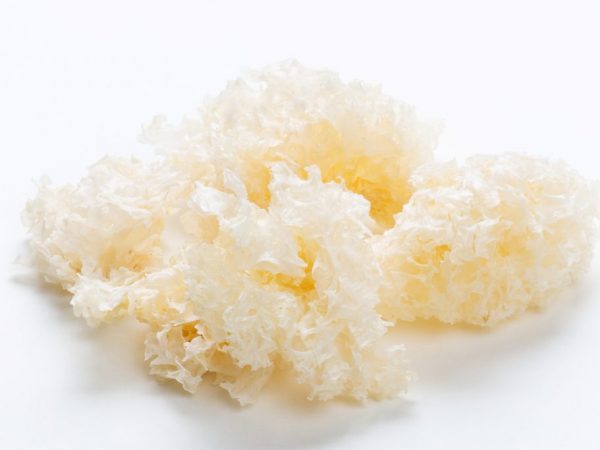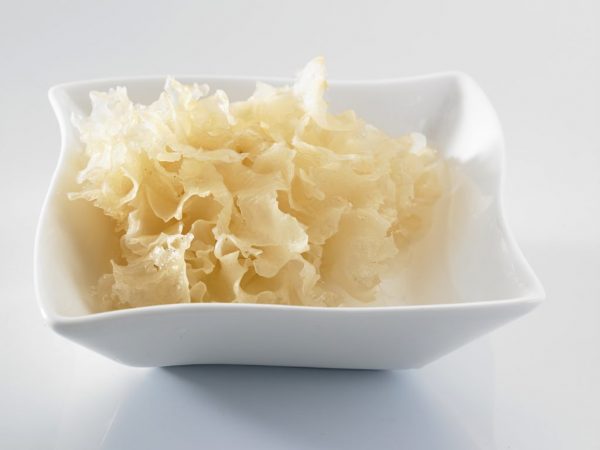Ice mushroom and its beneficial properties
Ice mushroom is an edible representative of the Tremella family, belonging to the genus with the same name - Tremella, which is translated from Latin as "Drozhalka". It is grown on an industrial scale.

Ice mushroom and its beneficial properties
Biological characteristic
The Chinese call the ice mushroom "snow ear", the Japanese have another name for it - "jellyfish mushroom". The scientific name is fucus tremella.
The mushroom got its name, strange at first glance, thanks to its unusual appearance. Its fruit body is translucent, white or yellowish in color. Outwardly, the mushroom looks like a jellyfish or small pieces of ice. The pulp is elastic, tender in consistency, has a mild odor with spicy notes.
The ice mushroom reaches 7.5-10 cm in diameter. By its nature, it belongs to Basidiomycetes, multiplies by spores that mature in Basidia.
The life cycle begins with parasitism on other species - it invades them with mycelium.
Irina Selyutina (Biologist):
The ice mushroom was first described by Michaels Berkeley (Great Britain) in 1856. Japanese biologist Yoshio Kobayashi described a species similar to Tremella fuciformis found in Japan. Later it was found that Nakaiomyces nipponicus, which had dark growths on the surface of its fruiting body, is that same fucus-shaped shiver, but the growths are ascomycetes parasitizing on it.
It is attached to the surface of the trees with a single squat leg, from which twisting blades with a huge number of folds extend.
Geography of distribution
The geography of distribution covers those areas where the fungus grows on which the tremella parasitizes - it is Archer's annulohypoxylon (saprotrophic fungus) or it will be old fallen branches and trunks of dead large-leaved trees, more often the common Indian mango. Grows singly or in small colonies.
In Primorye of Russia, fucus trimella was found in oak groves.
The natural habitat includes tropical and subtropical regions, including Asian countries, the Australian continent, Central America, the Pacific Islands and New Zealand.
For culinary purposes, fucus tremella is grown artificially.
Chemical composition and benefits
The benefit lies in its chemical composition rich in a vitamin-mineral complex. Its calorie content is 56 kcal per 100 g, including:
- proteins - 1.6 g,
- fats - 4.3 g,
- carbohydrates - 2.8 g,
- water in the mushroom - 91.3 g.
There is no dietary fiber in the mushroom pulp.
The artificially cultivated ice mushroom has a higher calorie content and reaches up to 86 kcal per 100 g.
The chemical composition of tremella contains vitamins of group B, A, D, E, microelements: magnesium, potassium, sodium, iron, sulfur and phosphorus. The benefits of the ice mushroom for human health are contained in 18 amino acids, including lysine, valine, glycine, cystine, methionine, etc., as well as high levels of glucose, polysaccharides and plant glycogens.
Practical use

The mushroom is used in cooking and cosmetology
The industrial cultivation of this species in China began in the 19th century. Tremella is used to prepare traditional Chinese soup, drinks, it acts as an ingredient for sweet desserts, including ice cream.
Irina Selyutina (Biologist):
On the territory of the post-Soviet space, the shiver fucus is sold as a "Korean" salad, which is called "sea mushroom" or "scallops". You can buy dried shiver in supermarkets. After soaking, the appearance of the mushroom is no different from the freshly harvested one.
The benefits of the mushroom:
- enhances immunity;
- increases the body's resistance to radiation, accelerates recovery processes, shortening the rehabilitation period after chemotherapy;
- normalizes the respiratory system;
- stabilizes the activity of the heart and blood vessels, improves the functioning of the hematopoietic organs, strengthening the micromuscular tone, preventing the deposition of cholesterol on the walls of blood vessels;
- prevents the development of thromfolebitis and varicose veins, harmonizes blood clotting processes;
- prevents an increase in blood sugar levels;
- acts as an anti-allergenic agent;
- improves the activity of internal organs, including the spleen, gastrointestinal tract, stimulating the outflow of bile and increasing the rate of intestinal motility.
In cosmetology, mushroom pulp is a remedy for wrinkles, it is used in the form of anti-aging masks and as part of decorative cosmetics.
Contraindications
Fucus tremella can harm the health of young children under 3 years of age, pregnant and lactating women.
It is not recommended to use it simultaneously with drugs that reduce blood clotting (anticoagulants).
Conclusion
The beneficial properties of ice mushroom are widely used in Asian cooking. It acts as an ingredient in first, second courses and desserts. With excessive use, it can cause minor harm to health - a slight disorder of the gastrointestinal tract function. Allowed for food purposes subject to restrictions.



